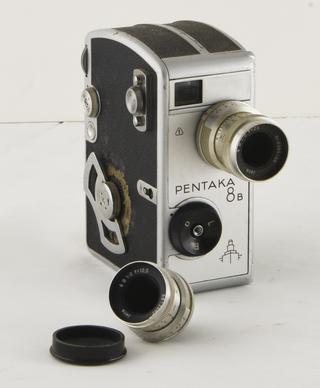Biokam ciné camera
Spare parts for early Biokam camera; spare spindle, brass threaded knob, spool of film or backing paper(?), spool box for printing and two film cassette type holders and 'projection' lens.
More
One of the earliest amateur cine devices, the Biokam could be used as a movie or stills camera, projector, printer and enlarger. It used 17.5mm film with central perforations between frames (like the later 9.5mm film).
One of the earliest amateur cine devices, the Biokam was demonstrated by T C Hepworth at the London Camera Club on 24th March 1899, where it was advertised as ‘A combined Cinematograph & Snap-Shot Camera, Printer, Projector, Reverser and Enlarger’. It used 17.5mm film with central perforations between frames (like the later 9.5mm film). The film box had two separate compartments, so that two rolls of film could be exposed in succession. The mechanism unit could be converted into a printer, and with the addition of a light source, into a projector. Distributed by the Warwick Trading Company, the full outfit cost eleven guineas (£11.55).
- Materials:
- brass (copper, zinc alloy) , glass and wood (unidentified)
- Object Number:
- 1932-490 Pt1






